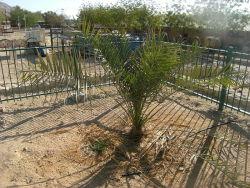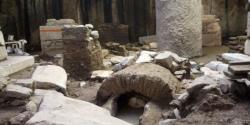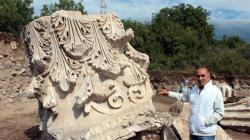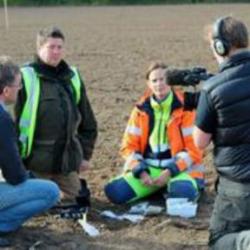INSTITUT SUPERIEUR D'ANTHROPOLOGIE
INSTITUTE OF ANTHROPOLOGY
ONLINE COURSES / COURS A DISTANCE
FALL TERM : OCTOBER 2013
REGISTER NOW
ISRAËL -  Masada - During excavations by the late Ehud Netzer in 1973 at the site of Herod the Great's fortified mountaintop palace at Masada in Israel, archeologists uncovered a cache of seeds stowed away in a clay jar about 2,000 years ago. For decades, the ancient seeds were stored in a drawer at Tel Aviv's Bar-Ilan University. But in 2005, in collaboration with the Louis L. Borick Natural Medicine Center at Hadassah Hospital in Jerusalem, botanical researcher Elaine Solowey received one of them for an experimental planting. "When we asked if we could try and grow some of them, they said, 'You're mad,' but they gave us three seeds," she said. "Lotus seeds over 1,000 years old have been sprouted, and I realized that no one had done any similar work with dates, so why not give it our best shot -- and we were rewarded."* Solowey planted a seed in a pot at Kibbutz Ketura in January, immediately after receiving them. Since then, it has sprouted into a seedling, produced its first blossom in 2011, and now flourishes as a young date palm. It has been nick-named "Methuselah", after the oldest person who ever lived, according to the biblical account. At first blush, it appears no different than thousands of other modern date palms growing throughout Israel and the Middle East. But looking a little closer, one sees a distinction. "The only difference between this date seedling and any other date seedlings I've seen come up is the length of the third leaf. This is very unusual," Solowey said. The fruit of this ancient tree, the Judean date, has been recorded in ancient literature as having valuable properties. It is said to have been an aphrodisiac, a contraceptive, and a cure for diseases such as cancer, malaria and toothaches. For Christianity, the palm has been regarded as a symbol of peace, the ancient Hebrews referred to it as a "tree of life" for its food properties and shade, and Arabic populations have used it for a vast variety of purposes. Upon entering Judea, the Romans observed prolific forests or groves in the Jordan River valley, extending from the Sea of Galilee to the Dead Sea. It was a major element of the area's economy. Interestingly, they called the date palm "the date-bearing phoenix", as it never seemed to die and was able to flourish in the desert where other plants could not survive. Solowey and colleagues hope to be able to cross-breed the plant with other closley related date palm types.
Masada - During excavations by the late Ehud Netzer in 1973 at the site of Herod the Great's fortified mountaintop palace at Masada in Israel, archeologists uncovered a cache of seeds stowed away in a clay jar about 2,000 years ago. For decades, the ancient seeds were stored in a drawer at Tel Aviv's Bar-Ilan University. But in 2005, in collaboration with the Louis L. Borick Natural Medicine Center at Hadassah Hospital in Jerusalem, botanical researcher Elaine Solowey received one of them for an experimental planting. "When we asked if we could try and grow some of them, they said, 'You're mad,' but they gave us three seeds," she said. "Lotus seeds over 1,000 years old have been sprouted, and I realized that no one had done any similar work with dates, so why not give it our best shot -- and we were rewarded."* Solowey planted a seed in a pot at Kibbutz Ketura in January, immediately after receiving them. Since then, it has sprouted into a seedling, produced its first blossom in 2011, and now flourishes as a young date palm. It has been nick-named "Methuselah", after the oldest person who ever lived, according to the biblical account. At first blush, it appears no different than thousands of other modern date palms growing throughout Israel and the Middle East. But looking a little closer, one sees a distinction. "The only difference between this date seedling and any other date seedlings I've seen come up is the length of the third leaf. This is very unusual," Solowey said. The fruit of this ancient tree, the Judean date, has been recorded in ancient literature as having valuable properties. It is said to have been an aphrodisiac, a contraceptive, and a cure for diseases such as cancer, malaria and toothaches. For Christianity, the palm has been regarded as a symbol of peace, the ancient Hebrews referred to it as a "tree of life" for its food properties and shade, and Arabic populations have used it for a vast variety of purposes. Upon entering Judea, the Romans observed prolific forests or groves in the Jordan River valley, extending from the Sea of Galilee to the Dead Sea. It was a major element of the area's economy. Interestingly, they called the date palm "the date-bearing phoenix", as it never seemed to die and was able to flourish in the desert where other plants could not survive. Solowey and colleagues hope to be able to cross-breed the plant with other closley related date palm types.
http://popular-archaeology.com/issue/09012013/article/ancient-date-palm-tree-flourishes-again
GRECE –  Thessalonique - When a brand-new subway system hits an ancient road, surely something has to give. But in the northern Greek city of Thessaloniki, archaeologists are fighting to combine the two, against government plans to remove and display elsewhere a large section of an ancient Roman thoroughfare found on a planned subway station. Some 200 people, including many state-employed archaeologists, on Monday formed a chain round the central Thessaloniki site, beating drums and holding a banner reading “Culture is not business.” The protest was organized by the Association of Greek Archaeologists, which wants the metro station re-designed to incorporate the ancient remains and has raised more than 12,000 signatures in an online petition to preserve the road. The 76-meter- (250-foot) long and 7.5-meter-(25-foot) wide stretch of road—a junction of the city’s main road with a smaller street—mostly dates to the 4th century, with 6th century additions. Archaeologists also unearthed the remains of a row of shops, including many jewelers’ workshops, a collapsed monumental stone arch, a sewage conduit and water pipes running parallel to the road. Thessaloniki was founded in the 4th century BC and became an important city during Byzantine times. Remains of its past stud the modern city center, including mediaeval churches, city walls, a Roman marketplace, a monumental arch and the perfectly preserved Rotunda, a Roman building dating to the 4th century AD that later served as a church.
Thessalonique - When a brand-new subway system hits an ancient road, surely something has to give. But in the northern Greek city of Thessaloniki, archaeologists are fighting to combine the two, against government plans to remove and display elsewhere a large section of an ancient Roman thoroughfare found on a planned subway station. Some 200 people, including many state-employed archaeologists, on Monday formed a chain round the central Thessaloniki site, beating drums and holding a banner reading “Culture is not business.” The protest was organized by the Association of Greek Archaeologists, which wants the metro station re-designed to incorporate the ancient remains and has raised more than 12,000 signatures in an online petition to preserve the road. The 76-meter- (250-foot) long and 7.5-meter-(25-foot) wide stretch of road—a junction of the city’s main road with a smaller street—mostly dates to the 4th century, with 6th century additions. Archaeologists also unearthed the remains of a row of shops, including many jewelers’ workshops, a collapsed monumental stone arch, a sewage conduit and water pipes running parallel to the road. Thessaloniki was founded in the 4th century BC and became an important city during Byzantine times. Remains of its past stud the modern city center, including mediaeval churches, city walls, a Roman marketplace, a monumental arch and the perfectly preserved Rotunda, a Roman building dating to the 4th century AD that later served as a church.
http://www.archaiologia.gr/en/blog/2013/10/08/human-chain-to-save-antiquities/
DANEMARK –  Lundy Mose - Big-game hunts about 12,000 years ago involved feasting on a meaty morsel popular with today’s gourmets, followed by chopping, hauling, bone tossing, jewelry making and boasting. All of these activities are suggested by remains found at a prehistoric Danish butchering site, called Lundy Mose, which is described in a paper accepted for publication in the Journal of Archaeological Science. Bone fragments belonging to wild boar, red deer and aurochs were unearthed. But the hunters clearly had a taste for elk meat, since elk remains were prevalent at the site, located in South Zealand, Denmark. “Due to very good conditions of bone preservation, Lundby Mose offers exceptional opportunities for detailed reconstruction of exploitation patterns, and allows a very precise picture of the different activities involved in elk exploitation,” archaeologist Charlotte Leduc of the University of Paris wrote. Her detailed analysis of the remains determined that the hunters first cut around the elk heads and other parts of the body in order to remove the hides. At least one of the hides then likely became a perishable container, comparable to a garbage bag, upon which refuse was placed and later bundled. The hunters then removed meat from easy-to-access parts, such as the limbs, and likely feasted on it right then and there. No roasting pit or evidence for fire is mentioned, so it might have been consumed raw. All skeletal parts containing marrow -- now a delicacy in many fine restaurants -- were fractured to enable its extraction. Wietske Prummel of the University of Groningen, who analyzed another prehistoric Northern European butchering site, told Discovery News that marrow was usually “consumed by hunters immediately after butchering. It was their reward for the successful kill.”
Lundy Mose - Big-game hunts about 12,000 years ago involved feasting on a meaty morsel popular with today’s gourmets, followed by chopping, hauling, bone tossing, jewelry making and boasting. All of these activities are suggested by remains found at a prehistoric Danish butchering site, called Lundy Mose, which is described in a paper accepted for publication in the Journal of Archaeological Science. Bone fragments belonging to wild boar, red deer and aurochs were unearthed. But the hunters clearly had a taste for elk meat, since elk remains were prevalent at the site, located in South Zealand, Denmark. “Due to very good conditions of bone preservation, Lundby Mose offers exceptional opportunities for detailed reconstruction of exploitation patterns, and allows a very precise picture of the different activities involved in elk exploitation,” archaeologist Charlotte Leduc of the University of Paris wrote. Her detailed analysis of the remains determined that the hunters first cut around the elk heads and other parts of the body in order to remove the hides. At least one of the hides then likely became a perishable container, comparable to a garbage bag, upon which refuse was placed and later bundled. The hunters then removed meat from easy-to-access parts, such as the limbs, and likely feasted on it right then and there. No roasting pit or evidence for fire is mentioned, so it might have been consumed raw. All skeletal parts containing marrow -- now a delicacy in many fine restaurants -- were fractured to enable its extraction. Wietske Prummel of the University of Groningen, who analyzed another prehistoric Northern European butchering site, told Discovery News that marrow was usually “consumed by hunters immediately after butchering. It was their reward for the successful kill.”
http://news.discovery.com/history/archaeology/butchering-circa-10000-bc-131007.htm
TURQUIE –  Kyzikos - During excavations at the Temple of Kyzikos Hadrian in the northwestern province of Balıkesir’s Erdek district, the world’s biggest Corinthian-style column head was unearthed. The column head dates back to the Roman period. The head of the excavations and Atatürk University Archaeology Department Associate Professor Nurettin Koçhan said this year’s excavations in the temple had started on Aug. 15 and would end on Oct. 8. He said besides architecturally decorated pieces, the excavations had unearthed the broken piece of human figures, the claw of a very big eagle and the head of a bull in temple friezes (a long narrow band of sculpture that runs along the architrave of temples). “The Temple of Hadrian, which is equal to Didim’s Apollo and the Ephesus Artemis temples in terms of size, is different from the others with the use of gilt in women figures and red and blue colors in its decoration. Also, the column heads have so far been unearthed in pieces, but this year a column head was found in one piece. The Temple of Hadrian is 116.2 meters long. The other temples are almost the same size but in Hadrian, decorations are red and blue and the hair of the women figures are decorated with gilt.” Koçhan said what they found this year was different and significant for the world of archaeology. “This is the Corinth column head, which is nearly 20 meters high and one of the three column heads in the temples,” he said. “The world’s biggest temple column head was found in Balıkesir,” Koçhan added, continuing, “With 1.9 calibers and 2.50 meter height, this is biggest and the most elegant Corinth column head made within the borders of the Roman Empire. There is no other one in the Corinth style. When we compare it to the Baalbek Temple of Jupiter in Lebanon, which is regarded as the world’s biggest and the most magnificent Corinth style temple, the Temple of Kyzikos Hadrian comes ahead.
Kyzikos - During excavations at the Temple of Kyzikos Hadrian in the northwestern province of Balıkesir’s Erdek district, the world’s biggest Corinthian-style column head was unearthed. The column head dates back to the Roman period. The head of the excavations and Atatürk University Archaeology Department Associate Professor Nurettin Koçhan said this year’s excavations in the temple had started on Aug. 15 and would end on Oct. 8. He said besides architecturally decorated pieces, the excavations had unearthed the broken piece of human figures, the claw of a very big eagle and the head of a bull in temple friezes (a long narrow band of sculpture that runs along the architrave of temples). “The Temple of Hadrian, which is equal to Didim’s Apollo and the Ephesus Artemis temples in terms of size, is different from the others with the use of gilt in women figures and red and blue colors in its decoration. Also, the column heads have so far been unearthed in pieces, but this year a column head was found in one piece. The Temple of Hadrian is 116.2 meters long. The other temples are almost the same size but in Hadrian, decorations are red and blue and the hair of the women figures are decorated with gilt.” Koçhan said what they found this year was different and significant for the world of archaeology. “This is the Corinth column head, which is nearly 20 meters high and one of the three column heads in the temples,” he said. “The world’s biggest temple column head was found in Balıkesir,” Koçhan added, continuing, “With 1.9 calibers and 2.50 meter height, this is biggest and the most elegant Corinth column head made within the borders of the Roman Empire. There is no other one in the Corinth style. When we compare it to the Baalbek Temple of Jupiter in Lebanon, which is regarded as the world’s biggest and the most magnificent Corinth style temple, the Temple of Kyzikos Hadrian comes ahead.
http://www.hurriyetdailynews.com/worlds-biggest-column-head-found-in-balikesir.aspx?pageID=238&nID=55768&NewsCatID=375
ROYAUME UNI –  Towton - Archaeologists believe they have found a chapel built by Richard III to commemorate the Yorkist victory in one of the bloodiest battles ever fought on English soil. As the row continues to rage over whether the Plantagenet king’s remains should be laid to rest in Leicester or York, a new discovery in a peaceful field on the outskirts of York has unearthed more of his legacy. The land was where the Battle of Towton was fought; the bloody clash between the Lancastrians and Yorkists in the War of the Roses. According to accounts at the time, it left 28,000 soldiers dead, causing rivers to have run red with blood and survivors fleeing across “bridges of bodies”. It led to the Yorkist king Edward being crowned Edward IV. After his death, his younger brother, Richard III, took to the throne and began building a chapel at Towton, near York, in 1483 to commemorate the battle. Richard III died two years later at the Battle of Bosworth Field, in Leicester and the chapel was never completed. It fell into decline and by the late 1500s had disappeared altogether. Now archaeologists believe they may have found evidence of his lost chapel. A University of York spokesman for the department stressed the research so far looked positive, but said researchers can’t prove exactly where the chapel was until a larger excavation has taken place. But lead archaeologist, Tim Sutherland, from the university, said they had found lead and glass from the windows and worked stone which proved archaeological evidence the chapel exists.
Towton - Archaeologists believe they have found a chapel built by Richard III to commemorate the Yorkist victory in one of the bloodiest battles ever fought on English soil. As the row continues to rage over whether the Plantagenet king’s remains should be laid to rest in Leicester or York, a new discovery in a peaceful field on the outskirts of York has unearthed more of his legacy. The land was where the Battle of Towton was fought; the bloody clash between the Lancastrians and Yorkists in the War of the Roses. According to accounts at the time, it left 28,000 soldiers dead, causing rivers to have run red with blood and survivors fleeing across “bridges of bodies”. It led to the Yorkist king Edward being crowned Edward IV. After his death, his younger brother, Richard III, took to the throne and began building a chapel at Towton, near York, in 1483 to commemorate the battle. Richard III died two years later at the Battle of Bosworth Field, in Leicester and the chapel was never completed. It fell into decline and by the late 1500s had disappeared altogether. Now archaeologists believe they may have found evidence of his lost chapel. A University of York spokesman for the department stressed the research so far looked positive, but said researchers can’t prove exactly where the chapel was until a larger excavation has taken place. But lead archaeologist, Tim Sutherland, from the university, said they had found lead and glass from the windows and worked stone which proved archaeological evidence the chapel exists.
http://www.darlingtonandstocktontimes.co.uk/news/10720671._/
FRANCE –  Saintes - En préalable à la construction de trois maisons individuelles, situées entre la rue Daniel-Massiou et la rue des Thermes Romains à Saintes, une fouille préventive a été prescrite par l’État (Drac Poitou-Charentes) et menée par les archéologues de l’Inrap, sur une surface de 3 000 m². L’extension urbaine ces vingt dernières années a concerné essentiellement la périphérie de la ville antique de Saintes, Mediolanum Santonum, donnant lieu à des recherches axées sur l’étude des nécropoles antiques. Cette nouvelle fouille offre la possibilité d’étudier le quartier nommé Saint-Saloine, sur une surface importante, dans un secteur proche des thermes ayant déjà fait l’objet de fouilles anciennes, comme celles de l’extension du cimetière Saint Vivien. L’objectif de ces recherches consiste à étudier l’évolution de ce secteur du nord de Saintes, abritant une importante activité artisanale (métallurgie, céramique, verrerie, travail de l’os, etc.) dès l’époque augustéenne (fin du Ier siècle avant et début du Ier siècle de notre ère), avant d’être urbanisé dans le courant du Ier siècle, puis progressivement abandonné avec la mise en place de nécropoles du IIIe siècle jusqu’au VIIe siècle.
Saintes - En préalable à la construction de trois maisons individuelles, situées entre la rue Daniel-Massiou et la rue des Thermes Romains à Saintes, une fouille préventive a été prescrite par l’État (Drac Poitou-Charentes) et menée par les archéologues de l’Inrap, sur une surface de 3 000 m². L’extension urbaine ces vingt dernières années a concerné essentiellement la périphérie de la ville antique de Saintes, Mediolanum Santonum, donnant lieu à des recherches axées sur l’étude des nécropoles antiques. Cette nouvelle fouille offre la possibilité d’étudier le quartier nommé Saint-Saloine, sur une surface importante, dans un secteur proche des thermes ayant déjà fait l’objet de fouilles anciennes, comme celles de l’extension du cimetière Saint Vivien. L’objectif de ces recherches consiste à étudier l’évolution de ce secteur du nord de Saintes, abritant une importante activité artisanale (métallurgie, céramique, verrerie, travail de l’os, etc.) dès l’époque augustéenne (fin du Ier siècle avant et début du Ier siècle de notre ère), avant d’être urbanisé dans le courant du Ier siècle, puis progressivement abandonné avec la mise en place de nécropoles du IIIe siècle jusqu’au VIIe siècle.
http://www.inrap.fr/archeologie-preventive/Actualites/Communiques-de-presse/p-16421-L-Inrap-fete-la-science-a-Saintes-visite-guidee-d-un-chantier-de-fouilles-archeologiques-dimanche-13-octobre-2013.htm
CANADA –  Toronto - An archeological dig on the site of The Globe and Mail’s new headquarters in the oldest part of Toronto has revealed the remains of Berkeley House – home to a man who killed the attorney-general of Upper Canada in a duel fought over gossip his wife slept around. “It’s a miracle that these foundations exist,” said archeologist Keith Powers as he surveyed the newly uncovered walls and beams that have somehow survived Toronto’s transformation from muddy colonial capital to development-hungry metropolis. But the past has ways of persisting, thanks to city planning laws that require developers to undertake archeological assessments in heritage areas before they get to build our glass towers. The regeneration of the east-of-Jarvis neighbourhood that formed the original town of York is now laying bare 200-year-old rivalries and innuendos that were rife in an overly intimate government town of 400 people where everyone was jockeying for position. The 17-storey Globe and Mail Centre, due to be completed in 2016, will occupy the site of a house owned by John Small, the clerk of Upper Canada’s executive council and a well-connected man who couldn’t resist putting himself at the centre of things. Not content with playing host to government meetings while the nearby Parliament was being constructed, he used to stand in his doorway on King St. E., west of present-day Berkeley St., and shout at passers-by to join him for a good dinner.
Toronto - An archeological dig on the site of The Globe and Mail’s new headquarters in the oldest part of Toronto has revealed the remains of Berkeley House – home to a man who killed the attorney-general of Upper Canada in a duel fought over gossip his wife slept around. “It’s a miracle that these foundations exist,” said archeologist Keith Powers as he surveyed the newly uncovered walls and beams that have somehow survived Toronto’s transformation from muddy colonial capital to development-hungry metropolis. But the past has ways of persisting, thanks to city planning laws that require developers to undertake archeological assessments in heritage areas before they get to build our glass towers. The regeneration of the east-of-Jarvis neighbourhood that formed the original town of York is now laying bare 200-year-old rivalries and innuendos that were rife in an overly intimate government town of 400 people where everyone was jockeying for position. The 17-storey Globe and Mail Centre, due to be completed in 2016, will occupy the site of a house owned by John Small, the clerk of Upper Canada’s executive council and a well-connected man who couldn’t resist putting himself at the centre of things. Not content with playing host to government meetings while the nearby Parliament was being constructed, he used to stand in his doorway on King St. E., west of present-day Berkeley St., and shout at passers-by to join him for a good dinner.
http://www.theglobeandmail.com/news/toronto/archeologists-find-link-to-200-year-old-scandal-under-new-globe-home/article14719339/?cmpid=rss1&utm_source=feedburner&utm_medium=feed&utm_campaign=Feed